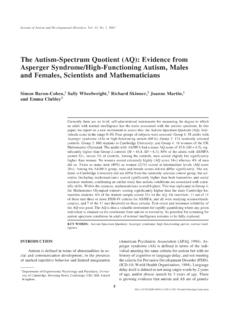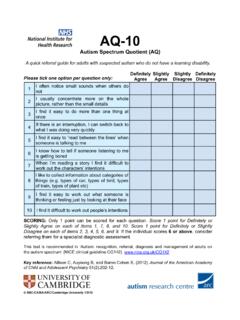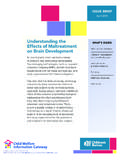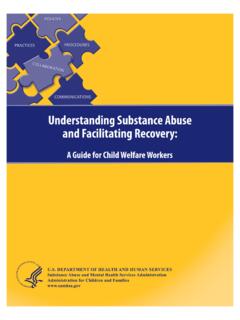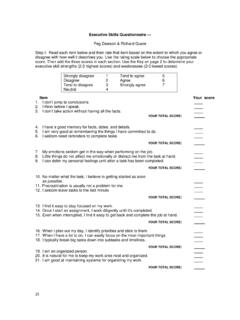Transcription of The Autism-Spectrum Quotient (AQ): Evidence from Asperger …
1 Journal of Autism and Developmental Disorders, Vol. 31, No. 1, 2001 The Autism-Spectrum Quotient (AQ): Evidence fromAsperger Syndrome/High- functioning Autism, Malesand Females, Scientists and MathematiciansSimon Baron-Cohen,1 Sally Wheelwright,1 Richard Skinner,1 Joanne Martin,1and Emma Clubley1 Currently there are no brief, self-administered instruments for measuring the degree to whichan adult with normal intelligence has the traits associated with the autistic spectrum. In thispaper, we report on a new instrument to assess this: the Autism-Spectrum Quotient (AQ). Indi-viduals score in the range 0 50. Four groups of subjects were assessed: Group 1: 58 adults withAsperger syndrome (AS) or high- functioning autism (HFA); Group 2: 174 randomly selectedcontrols. Group 3: 840 students in Cambridge University; and Group 4: 16 winners of the UKMathematics Olympiad.
2 The adults with AS/HFA had a mean AQ score of (SD= ), sig-nificantly higher than Group 2 controls (M= , SD= ). 80% of the adults with AS/HFAscored 32+, versus 2% of controls. Among the controls, men scored slightly but significantlyhigher than women. No women scored extremely highly (AQ score 34+) whereas 4% of mendid so. Twice as many men (40%) as women (21%) scored at intermediate levels (AQ score20+). Among the AS/HFA group, male and female scores did not differ significantly. The stu-dents in Cambridge University did not differ from the randomly selected control group, but sci-entists (including mathematicians) scored significantly higher than both humanities and socialsciences students, confirming an earlier study that autistic conditions are associated with scien-tific skills. Within the sciences, mathematicians scored highest. This was replicated in Group 4,the Mathematics Olympiad winners scoring significantly higher than the male Cambridge hu-manities students.
3 6% of the student sample scored 32+on the AQ. On interview, 11 out of 11of these met three or more DSM-IV criteria for AS/HFA, and all were studying sciences/math-ematics, and 7 of the 11 met threshold on these criteria. Test retest and interrater reliability ofthe AQ was good. The AQ is thus a valuable instrument for rapidly quantifying where any givenindividual is situated on the continuum from autism to normality. Its potential for screening forautism spectrum conditions in adults of normal intelligence remains to be fully WORDS: Autism-Spectrum Quotient ; Asperger syndrome; high- functioning autism; normal is defined in terms of abnormalities in so-cial and communication development, in the presenceof marked repetitive behavior and limited imagination(American Psychiatric Association [APA], 1994). As-perger syndrome (AS) is defined in terms of the indi-vidual meeting the same criteria for autism but with nohistory of cognitive or language delay, and not meetingthe criteria for Pervasive Development Disorder (PDD),(ICD-10; World Health Organization, 1994).
4 Languagedelay itself is defined as not using single words by 2 yearsof age, and/or phrase speech by 3 years of age. Thereis growing Evidence that autism and AS are of genetic50162-3257/01/0200-0005$ 2001 Plenum Publishing Corporation1 Departments of Experimental Psychology and Psychiatry, Univer-sity of Cambridge, Downing Street, Cambridge, CB2 3EB, The Evidence is strongest for autism, and comesfrom twin and behavioral genetic family studies (Bai-ley et al.,1995; Bolton & Rutter, 1990; Folstein & Rut-ter, 1977, 1988). Family pedigrees of AS also implicateheritability (Gillberg, 1991). There is also an assump-tion, still under debate, that autism and AS lie on a con-tinuumof social-communication disability, with AS asthe bridge between autism and normality (Baron-Cohen,1995; Frith, 1991; Wing, 1981, 1988). The continuumview shifts us away from categorical diagnosis and to-wards a there are no brief, self-administeredinstruments available for measuring where any givenindividual adult, with normal intelligence, lies on thiscontinuum.
5 Existing instruments, such as the ADI-R(Autism Diagnostic Interview) (Le Couteur et al.,1989;Lord, Rutter, & Le Couteur, 1994), the ADOS-G(Autism Diagnostic Observation Schedule) are fairlytime-consuming to administer, and the CARS ( child -hood Autism Rating Scale) which can be brief, is notself-administered (Schopler, Reichler, & Renner,1986). What is needed is a short, self-administeredscale for identifying the degree to which any individ-ual adult of normal IQ may have autistic traits orwhat has been called the broader phenotype (Baileyet al.,1995). This would be useful for both scientificreasons ( , establishing who is affected and whois not, or the degree of caseness of an individual, in sci-entific comparisons), and potentially for applied rea-sons ( , screening for possibly affected individualsto assist in making referrals for a full diagnostic as-sessment).
6 For both of these reasons, we developed theAutism-Spectrum Quotient (AQ). The instrument sname was chosen because of the assumption, mentionedabove, that there is an autism spectrum (Wing, 1988).2 DESIGN OF THE AQThe AQ was designed to be short, easy to use, andeasy to score. It is shown in the Appendix. It comprises50 questions, made up of 10 questions assessing 5 dif-ferent areas: social skill(items 1,11,13,15,22,36,44,45,47,48); attention switching(items 2,4,10,16,25,32,34,37,43,46); attention to detail(items 5,6,9,12,19,23,28,29,30,49); communication(items 7,17,18,26,27,31,33,35,38,39); imagination(items 3,8,14,20,21,24,40,41,42,50). Each of the items listed above scores 1 point if6 Baron-Cohen, Wheelwright, Skinner, Martin, and Clubleythe respondent records the abnormal or autistic-like be-havior either mildly or strongly (see below for scoringeach item; Abnormality =poor social skill, poor com-munication skill, poor imagination, exceptional atten-tion to detail, poor attention-switching/strong focus ofattention).
7 Approximately half the items were wordedto produce a disagree response, and half an agree response, in a high scoring person with AS/HFA. Thiswas to avoid a response bias either way. Following this,items were randomized with respect to both the ex-pected response from a high-scorer, and with respectto their DEVELOPMENTI tems were selected from the domains in the triad of autistic symptoms (APA, 1994; Rutter, 1978; Wing& Gould, 1979), and from demonstrated areas of cogni-tive abnormality in autism. The AQ as shown in the Ap-pendix is the outcome of piloting multiple versions, overseveral years. The instrument was piloted on adults withAS or high- functioning autism (HFA), and age-matchedcontrols. An early version was also interview-based, andrequired the coding of responses. Following piloting,items which controls scored on as often, or more often,than did people with autism/AS were to the concern over whether a condition likeHFA or AS might impair one s ability to understandthe items in the questionnaire, we checked compre-hension with the patients in our pilot study.
8 We did thisby calling some patients into our lab, selected at ran-dom, where we had the opportunity to ask them abouttheir responses. Comprehension of wording might be agreater problem in a less able population, but this in-strument is designed for high- functioning individualswho are perfectly able to read or discuss issues. Forcaution, however, parents independently completed anAQ for their child with AS/HFA. A related issue iswhether a condition like AS or HFA might impair thesubject s ability to judge their own social or commu-nicative behavior, due to subtle mind-reading problems(Baron-Cohen, 1995; Baron-Cohen, Jolliffe, Morti-more, & Robertson, 1997). If this occurred, this wouldlead a person to score lower on the AQ, rating theirown behavior as more appropriate than it might reallybe. Any inaccuracies of this kind would therefore, ifanything, lead to a conservative estimate of the per-son s true AQ score.
9 However, to guard against falsenegatives, we included questions in both the social andcommunication domains that ask about the person spreferences,rather than only asking them to judge their2 The term Quotient is not used in the arithmetic sense (the resultof dividing one quantity by another) but as derived from the Latinroot quotiens(how much or how many).own behavior. Piloting revealed that such able subjectswere certainly able to report on their own preferencesand what they find easy or difficult. Equally, items inthe other domains ask about their attentional prefer-ences or focus of attention ( , to dates, numbers,small sounds). There is no reason to expect that a high- functioning person with autism or AS would be at allimpaired in being able to report faithfully on suchitems. The final version of the AQ has a forced-choiceformat, can be self-administered, and is straightforwardto score since it does not depend on any interpretationin the groups of subjects were tested: Group 1 com-prised 58 adults with AS/HFA (45 male, 13 female).
10 This sex ratio of :1 (M:F) is similar to that found inother samples (Klin, Volkmar, Sparrow, Cicchetti, &Rourke, 1995). All subjects in this group had been di-agnosed by psychiatrists using established criteria forautism or AS (APA, 1994). They were recruited via sev-eral sources, including the National Autistic Society(UK), specialist clinics carrying out diagnostic assess-ments, and advertisements in newsletters/web pages foradults with AS/HFA. Their mean age was years(SD= , range = ). They had all attendedmainstream schooling and were reported to have an IQin the normal range. See below for a check of this. Theirmean number of years in education was (SD= ). Thirty-two had higher educational qualifications(university degrees). Their occupations reflected theirmixed socioeconomic status (SES). Because we couldnot confirm age of onset of language with any reliabil-ity (due to the considerable passage of time), these in-dividuals are grouped together, rather than attemptingto separate them into AS versus HFA.
